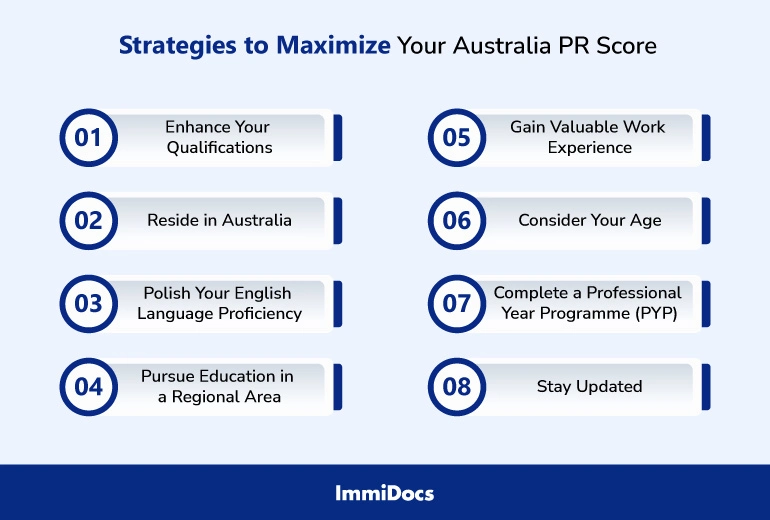Maximize Your Australia PR Points: A Comprehensive Guide

Maximize Your Australia PR Points: A Comprehensive Guide
Australia’s excellent quality of life and abundant career prospects have attracted many migrants. Its rich cultural diversity, captivating natural landscapes, top-tier educational institutions, and job availability further enhance its appeal as a highly sought-after place to call home. Australia has consistently warmly welcomed immigrants to address ongoing skill shortages across diverse industries.
Are you aspiring to become a permanent resident of Australia? If so, you must be familiar with the Australian PR point system, which is pivotal in determining your eligibility. Australia’s skilled migration program uses a point-based system to select candidates for PR visas.
In this comprehensive guide, we’ll walk you through everything you need to know to maximize your points for Australian permanent residency and increase your chances of securing that coveted status.
What is Permanent Residency?
Australia’s Permanent Residency Visa (PR) is a particular type of visa issued to foreign nationals who meet specific criteria set by the Department of Home Affairs (DoHA), which oversees Australian immigration. Holding an Australian PR (permanent resident) status allows individuals not citizens of Australia to work, live, and study within the country just like Australian citizens, without any limitations.
One avenue for skilled workers to secure PR is through the SkillSelect program, which operates on a point-based system. Applicants with the requisite skills required by Australia can express their interest in applying for PR. The list of high-demand skills in Australia is available in two key skill lists: the MLTSSL (Medium and Long-Term Strategic Skills List) and the STSOL (Short-Term Skilled Occupational Demand List). Those considering immigration to Australia and uncertain about the PR application process should first grasp how the PR point system functions.
Obtaining PR is transparent, with eligibility criteria easily accessible through official websites. PR points are allocated based on an individual’s current education, proficiency in English, and employment history.
The total PR points determine when an individual may receive an invitation to apply for PR, with a minimum score of 65 points required to lodge an Expression of Interest (EOI) for a PR application.
Below are the visa options available for skilled individuals:
- Skilled Independent visa subclass 189 (a permanent visa)
- Skilled Nominated visa subclass 190 (a permanent visa)
- Skilled Work Regional Provisional visa subclass 491
The point system ensures that immigrants possess the skills, character, and potential necessary to contribute to the country. Points are awarded based on age, qualifications, language proficiency, employment history, and the qualifications, language skills, and skills of one’s partner.
Read More: Requirements you need to know for VETASSESS Skills Assessment. 💡💡
Understanding the PR Points System
The Australian Permanent Residency point system evaluates applicants based on several factors, such as age, educational qualifications, work experience, English language proficiency, and more. To become eligible for Australian PR, you must score a minimum number of points, typically 65 points or more, out of a maximum of 100.
Calculating Your PR Points
Let’s delve into the nitty-gritty of calculating your points for Australian PR:
1. Age (Maximum 30 Points): Age is a crucial factor in the point system. Applicants between 25-32 years tend to score the maximum points, while points decrease with increasing age.
| Age (Years) | Points |
| 18 to 25 | 25 |
| 25 to 33 | 30 |
| 33 to 40 | 25 |
| 40 to 45 | 15 |
2. Educational Qualifications (Maximum 20 Points): Your educational background greatly influences your PR points. A Bachelor’s degree or higher in a field related to your nominated occupation can earn you the highest points.
3. Work Experience (Maximum 20 Points): Work experience in a skilled occupation is another significant contributor. The more years of relevant experience you have, the higher your point tally.
4. English Language Proficiency (Maximum 20 Points): Proficiency in English, assessed through tests like IELTS or TOEFL, can boost your points for Australian PR. Achieving superior language skills can earn you maximum points.
| Level | Points |
| Competent | 0 |
| Proficient | 10 |
| Superior | 20 |
5. Australian Work Experience (Maximum 20 Points): Prior work experience in Australia can significantly enhance your point tally.
6. Skilled Employment (Maximum 20 Points): Certain nominated occupations are in high demand in Australia. You can score additional points if your occupation is on the Skilled Occupation List (SOL).
| Number of Years | Points | |
| Overseas Skilled Employment (Outside Australia) | ||
| Up to 3 years | 0 | |
| 3 to 5 years | 5 | |
| 5 to 8 years | 10 | |
| Up to 8 years | 15 | |
| Overseas Skilled Employment (In Australia) | ||
| Up to 1 year | 0 | |
| 1 to 3 years | 5 | |
| 3-5 years | 10 | |
| 5 to 8 years | 15 | |
| Up to 8 years | 20 |
7. State or Territory Nomination (5-15 Points): Obtaining a nomination from an Australian state or territory can increase your PR points. Each region has its specific criteria and point allocations.
8. Partner Skills (Maximum 10 Points): If your partner qualifies for skilled migration, you can claim extra points for their skills and qualifications.
9. Other Factors (Up to 10 Points): Additional factors like having a close relative in Australia or studying in Australia can earn you extra points.
Learn More: Statutory Declarations and Affidavits for VETASSESS Skill Assessment. 💪💪
Strategies to Maximize Your Australia PR Points

Tip 1: Enhance Your Qualifications
Invest in your skills and knowledge by pursuing higher education, such as a Master’s or doctoral degree. While a diploma can earn you ten points on the GSM point system, a Master’s or doctoral degree can grant you up to fifteen and twenty points, respectively.
Tip 2: Reside in Australia
After completing your studies in Australia, consider applying for Visa Subclass 485, the Temporary Graduate Visa. This visa offers two streams: the post-study work stream and the graduate work stream. The post-study work stream allows you to work in Australia for 2 to 4 years, while the graduate work stream enables you to work for a maximum of 18 months. You can improve your English language skills and gain valuable work experience during this time, earning extra points on the GSM point grid.
Tip 3: Polish Your English Language Proficiency
Boosting your English language skills can help you accumulate points and enhance your chances of obtaining PR. Scoring a proficient 7 or equivalent on IELTS can earn you 10 points, while an exceptional score of 8 will net you 20 points.
Tip 4: Pursue Education in a Regional Area
Students who complete the Australian Study Requirement of 2 years in a regional area can qualify for an additional 5 points.
Tip 5: Gain Valuable Work Experience
Acquiring skilled employment in Australia or abroad can bolster your points tally. To claim points for work experience, you must have worked at least twenty hours per week in your nominated profession or closely related work. Consider gaining work experience alongside your studies or applying for the Subclass 485 Temporary Graduate Visa, which offers the opportunity to gain meaningful employment experience. You can earn up to five extra points with just one year of work experience in Australia.
Tip 6: Consider Your Age
Your age significantly impacts your points. Individuals between 25 and 32 receive the highest score of up to 30 points, while those aged between 45 and 49 are eligible for no points.
Tip 7: Complete a Professional Year Programme (PYP)
Participate in a Professional Year Programme (PYP) combining education and work experience. Completing this program provides Australian work experience and garners an additional five points. PYP typically runs for twelve months and is available for engineering, computer science, and accounting. The course must be in your nominated occupation or a closely related field to earn extra points.
Tip 8: Take your partner with you
If your de facto partner or spouse applies for the same skilled visa as you, you can claim an additional 10 PR points. It’s important to note that your partner cannot be an Australian citizen or permanent resident, and both of you must be under 45 and have a suitable skills assessment to qualify for these extra points. This provision encourages skilled couples to apply for visas together, increasing their chances of obtaining Australian permanent residency.
Tip 9: Stay Informed
Stay updated with the ever-changing immigration rules in Australia. Keep an eye on:
- SkillSelect: The points required and invitations issued may vary widely each SkillSelect round, affecting waiting periods and point requirements.
- State Nomination: Opportunities for state sponsorship can arise suddenly and fill up quickly.
- Occupations Lists: Skilled migration occupation lists frequently change, so stay informed.
- Employer Sponsorship: Employer-sponsored visas experience annual changes, especially for those requiring three years of Australian work for permanent residency.
Remaining current with immigration changes is crucial for maximizing your chances of obtaining Australian permanent residency.
Benefits of Australian PR
Once you obtain Australian permanent residency, you can live, work, and study in Australia for five years without restrictions. Australia’s strong economy, relaxed lifestyle, and high standard of living make it a top destination for immigrants worldwide.
Additional advantages of an Australian PR visa include:
- Eligibility to pursue higher education in Australia, with the option to apply for educational loans if needed.
- The ability to sponsor PR applications for eligible relatives.
- Permission to stay in Australia indefinitely and travel to and from the country without limitations.
- Australian citizenship for children born in Australia to PR visa holders.
- An agreement allowing Australian PR holders to apply for an NZ visa and travel to New Zealand.
- Access to social security benefits after holding PR status for at least two years, including childcare benefits, sickness allowance, unemployment benefits, age pension, family tax benefits, and more.
- Eligibility to apply for government positions and other professions, such as migration agents.
- Family members of PR holders are also eligible to join them.
Conclusion
To have a higher chance of getting a Permanent Resident in Australia, you should take the right steps and apply at the right time. The type of visa you apply for, where you plan to live in Australia, and the courses you pursue all play a significant role in determining your PR (Permanent Residency) points. In this article, we’ve outlined various ways to improve your PR for Australia. If you need more information or assistance, please get in touch with us and schedule a free consultation with one of our experts at ImmiDocs. We’re here to help you achieve your immigration goals and skill assessments.

